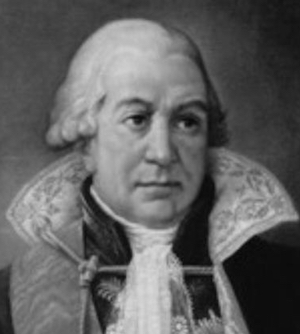General Louis-Auguste Jouvenel des Ursins d'Harville

Born: April 23, 1749
Place of Birth: Paris, Paris, France
Died: May 8, 1815
Place of Death: Harville, France
Arc de Triomphe: HARVILLE on the north pillar
Pronunciation:
A career soldier, Louis-Auguste Jouvenel des Ursins d'Harville was originally commissioned as a sous-lieutenant in the carabiniers in 1766. In 1770 he joined the gendarmerie and in 1784 he was named a Knight of Saint Louis. In 1786 d'Harville was named a major of the gendarmerie and and then two years later he was promoted to maréchal de camp.
After the onset of the Revolution, in early 1792 d'Harville was sent to the Army of the North where he was employed as a lieutenant general. He served as commander at Valenciennes in June of 1792 and then in August he served under Marshal Luckner in the Army of the Center. That September d'Harville served at the camp of Reims and then in October he served under General Dumouriez before fighting in November at Jemappes and Namur. In February of 1793 he commanded a corps stationed at Namur but then in April he was suspended and arrested after the defection of Dumouriez to the Austrians. D'Harville was conducted to Mézières and then Paris but was acquitted by the revolutionary tribunal. Nevertheless, he continued to be remain in custody until August of 1794 when he was released by order of the Committee of Public Safety.
D'Harville had to wait until June of 1795 before he was reemployed in the army when he was sent to the Army of the North. In July he was named commander of the 5th Division and then designated for the Army of the Sambre and Meuse, but he did not take up this position. Instead in August d'Harville took command of the 2nd Division of the Army of the North. In September the Committee of Public Safety ordered him to join the Army of the Sambre and Meuse and he joined that army in October, taking command of the cavalry during the army's retreat. That December d'Harville quit the army of the Sambre and Meuse.
In 1797 d'Harville became inspector general of cavalry and then in 1799 he became inspector general of the cavalry of the left wing of the Army of the Rhine. In April of 1800 he was appointed inspector general of cavalry of the Army of the Reserve, then in May he took command of a division of dragoons and heavy cavalry in the Army of the Reserve. D'Harville retired from the army in 1801 and was appointed a senator. In 1803 he was employed at Faenza and then in 1804 at Turin. In 1805 d'Harville was awarded with the Grand Eagle of the Legion of Honor and the following year he was named an equerry and knight of honor the Empress. More rewards followed, for in 1808 he was named a Count of the Empire and then later he was named governor of the Tuileries and the Louvre. After Napoleon's first abdication, d'Harville was named a Peer of France by the restored Bourbons.
Bibliography
Updated June 2016
© Nathan D. Jensen